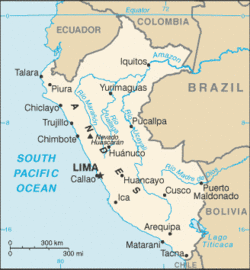Welcome to the Virtual Education Wiki ~ Open Education Wiki
Peru
Partners and experts situated in Peru
None
Peru in a nutshell
(sourced from http://en.wikipedia.org/wiki/Peru)
Peru (Spanish: Perú, Quechua: Piruw, Aymara: Piruw), officially the Republic of Peru (Spanish: República del Perú) is a country in western South America. It is bordered on the north by Ecuador and Colombia, on the east by Brazil, on the southeast by Bolivia, on the south by Chile, and on the west by the Pacific Ocean.

Peruvian territory was home to the Norte Chico civilization, one of the oldest in the world, and to the Inca Empire, the largest state in Pre-Columbian America. The Spanish Empire conquered the region in the 16th century and established a Viceroyalty, which included most of its South American colonies. After achieving independence in 1821, Peru has undergone periods of political unrest and fiscal crisis as well as periods of stability and economic upswing.
The population is just over 29 million.
The capital (and largest city) is Lima.
Peru is divided into 25 regions. Its geography varies from the arid plains of the Pacific coast to the peaks of the Andes mountains and the tropical forests of the Amazon Basin. It is a developing country with a medium Human Development Index score and a poverty level around 40%. Its main economic activities include agriculture, fishing, mining, and manufacturing of products such as textiles.
The Peruvian population is multiethnic, including Amerindians, Europeans, Africans and Asians. The main spoken language is Spanish (the only official language), although a significant number of Peruvians speak Quechua or other native languages. This mixture of cultural traditions has resulted in a wide diversity of expressions in fields such as art, cuisine, literature, and music.
Education in Peru
(sourced from http://en.wikipedia.org/wiki/Education_in_Peru - which is very brief and incomplete)
Education in Peru is under the jurisdiction of the Ministry of Education, which is in charge of formulating, implementing and supervising the national educational policy. According to the Constitution, education is compulsory and free in public schools for the initial, primary and secondary levels.
Education is also free in public universities for students who are unable to pay tuition and have an adequate academic performance.
As of 2008, various institutions such as UNESCO, World Bank, and the Inter-American Development Bank have stated that Peru has the best education system in Latin America and that primary, secondary, and superior education attendance rates were the highest in Latin America.
Schools in Peru
Further and Higher education in Peru
Universities in Peru
Peru has over 70 universities - see http://en.wikipedia.org/wiki/List_of_universities_in_Peru for a list. For a shorter list of around 20 with Wikipedia entries see http://en.wikipedia.org/wiki/Category:Universities_in_Peru
There are public universities and also private universities. One private university with an entry is:
Universidad del Pacífico (University of the Pacific)
Universidad del Pacífico (UP) is a private university established in 1962 by a group of Peruvian entrepreneurs supported by the Society of Jesus. Today is has become a university specialized in the areas of economics and business administration. In the past three decades, UP has been ranked as the most prestigious higher education institution in its fields of specialization in Peru, and among the leading institutions of its kind in the Latin American region. For details see http://en.wikipedia.org/wiki/University_of_the_Pacific_(Peru) and
Polytechnics in Peru
Colleges in Peru
Education reform
Schools
Post-secondary
Administration and finance
Schools
Post-secondary
Quality assurance
Schools
Post-secondary
Information society
ICT in education initiatives
Institucion Educativa Virtual del Callao Virtual school of Callao portal
Virtual initiatives in schools
Virtual initiatives in post-secondary education
There are two virtual campuses in the university sector:
- Universidad Andina Simón Bolívar - but note that Peru is a branch campus; the university is headquartered in Bolivia.
- Universidad Nacional Federico Villareal, based in Peru